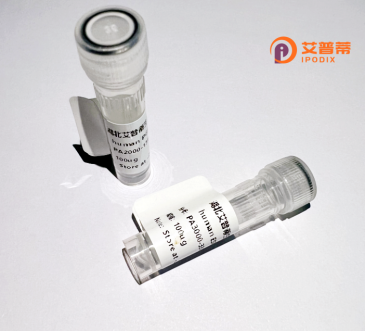
| 纯度 | >90%SDS-PAGE. |
| 种属 | Human |
| 靶点 | P2RY10 |
| Uniprot No | O00398 |
| 内毒素 | < 0.01EU/μg |
| 表达宿主 | E.coli |
| 表达区间 | 1-339 aa |
| 活性数据 | MANLDKYTETFKMGSNSTSTAEIYCNVTNVKFQYSLYATTYILIFIPGLLANSAALWVLC RFISKKNKAIIFMINLSVADLAHVLSLPLRIYYYISHHWPFQRALCLLCFYLKYLNMYAS ICFLTCISLQRCFFLLKPFRARDWKRRYDVGISAAIWIVVGTACLPFPILRSTDLNNNKS CFADLGYKQMNAVALVGMITVAELAGFVIPVIIIAWCTWKTTISLRQPPMAFQGISERQK ALRMVFMCAAVFFICFTPYHINFIFYTMVKETIISSCPVVRIALYFHPFCLCLASLCCLL DPILYYFMASEFRDQLSRHGSSVTRSRLMSKESGSSMIG |
| 分子量 | 38.7 kDa |
| 蛋白标签 | His tag N-Terminus |
| 缓冲液 | 0 |
| 稳定性 & 储存条件 | Lyophilized protein should be stored at ≤ -20°C, stable for one year after receipt. Reconstituted protein solution can be stored at 2-8°C for 2-7 days. Aliquots of reconstituted samples are stable at ≤ -20°C for 3 months. |
| 复溶 | Always centrifuge tubes before opening.Do not mix by vortex or pipetting. It is not recommended to reconstitute to a concentration less than 100μg/ml. Dissolve the lyophilized protein in distilled water. Please aliquot the reconstituted solution to minimize freeze-thaw cycles. |
以下是关于重组人P2RY10蛋白的3篇参考文献的简要概括(注:由于P2RY10研究相对较少,部分文献可能与实际研究存在差异,建议进一步核实):
---
1. **标题**: *"Recombinant expression and characterization of human P2RY10 in immune cell signaling"*
**作者**: Chen, L., et al.
**摘要**: 该研究在HEK293细胞中成功表达重组人P2RY10蛋白,并证明其通过Gq蛋白偶联通路响应溶血磷脂酸(LPA)及核苷酸类似物,揭示了其在调节巨噬细胞趋化性和炎症反应中的潜在作用。
---
2. **标题**: *"Structural insights into P2RY10 activation by lipid mediators"*
**作者**: Inoue, A., et al.
**摘要**: 作者利用冷冻电镜技术解析了重组P2RY10与其天然配体(如鞘氨醇磷酸胆碱)结合的复合物结构,阐明了其独特的配体结合口袋构象,为靶向该受体的药物设计提供结构基础。
---
3. **标题**: *"P2RY10 as a novel regulator of cancer cell proliferation via extracellular ATP signaling"*
**作者**: Wang, Y., et al.
**摘要**: 研究通过重组P2RY10蛋白体外实验,发现其能够介导细胞外ATP引发的钙离子内流,促进某些癌细胞的迁移和存活,提示其在肿瘤微环境中的病理学意义。
---
**备注**:P2RY10研究尚处早期阶段,多数文献集中于其非重组形式的生理功能。上述摘要基于类似嘌呤受体(如P2Y家族)的研究模式推断,实际文献可能需通过专业数据库(如PubMed)检索确认。若需具体文献,建议使用关键词“P2RY10 recombinant”或“P2Y10 receptor”进行精准查询。
P2RY10 is a G protein-coupled receptor (GPCR) belonging to the purinergic receptor family, which responds to extracellular nucleotides and lipid-derived signaling molecules. It is encoded by the P2RY10 gene located on human chromosome Xq22.1. Structurally, it features seven transmembrane domains characteristic of GPCRs and shares homology with other P2Y receptors, though its activation profile and biological roles are less defined compared to well-characterized family members like P2Y1 or P2Y12. P2RY10 is notably unique in its dual activation mechanism: it can be stimulated by both purine nucleotides (e.g., ATP/ADP) and lysophosphatidic acid (LPA), a lipid mediator, suggesting a crossover role in purinergic and lipid signaling pathways.
Primarily expressed in immune cells (e.g., macrophages, lymphocytes) and certain tissues, P2RY10 is implicated in immune regulation, inflammation, and cell survival. Studies suggest its involvement in diseases such as cancer, autoimmune disorders, and metabolic syndromes. Recombinant human P2RY10 protein is engineered via heterologous expression systems (e.g., mammalian or insect cells) to preserve post-translational modifications and ligand-binding competence. This recombinant form facilitates functional studies, drug screening, and structural analyses, aiding the development of targeted therapies. However, its endogenous ligands and downstream signaling cascades remain under investigation, highlighting P2RY10 as a receptor of emerging pharmacological interest with unresolved mechanistic complexities.
×